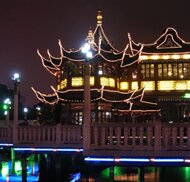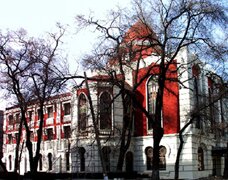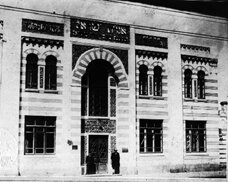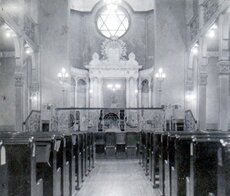| The Historic Community of Harbin, China |

|

|
|
Harbin, located in Northeast China, is the capital of the Heilongjiang Province and lies on the southern bank of the Songhua River.
 Harbin of today is one of the major cities of China and a rapidly growing industrial city as well as an economic, cultural and communication centre.
Despite an average temperature of -16.8 degrees Celsius in the winter, with temperatures falling as low as -38.1 degrees Celsius, Harbin is also now a major tourist attraction. Since 1985 it has hosted the internationally acclaimed annual Harbin International Ice and Snow Sculpture Festival. It scarcely resembles the Harbin of the early and middle nineteenth century. This once sleepy, cluster of small villages, was about to change and become an important part of the landscape of China at the same time as it was about to collide with the history of the Jewish Diaspora. Many of the Jews arrived fleeing the pogroms and persecution of Czarist Russia, while others were adventurer seekers drawn by the opportunity of the unknown. It was a chance for the early Jewish residents to make a new start and grow their own unique network of Jewish Diaspora organisations and institutions far from all that was familiar to them and removed from all major arteries of Jewish life. In 1898 the construction of the Chinese Eastern Railway, an extension of the Trans-Siberian railroad by Russia commenced. Harbin was transformed into a mini-international metropolis. The first Jew, S.I. Bertsel, arrived in 1899 and soon the first recorded Harbin “minyan†took place in 1900 in the home of I.L. Bach. Services were conducted in the home of the Berkovich family until 1902 when the Spiritual Committee was formed and the first synagogue was established. The Jewish population in 1902 was over three hundred. While the first synagogue was small, it became clear that this group of refugees was quite serious about making Harbin their home. Jewish businesses sprouted up and the community recruited a sochet. Rabbi Shneur Zalman Gashkel served as the community’s first rabbi. He was followed by Rabbi Levin who later went on to serve the Tientsin community. Â
In that same year, the Jewish cemetery was established and quickly served to ensure that the Jewish soldiers who perished in the Russo-Japanese War were given proper, Jewish burials. The cemetery housed an estimated 3000 graves in 1958 according to estimates recorded. A burial society functioned on an entirely voluntary basis. Poor were buried free of charge and a minyan was always available. The cemetery was moved by the municipal government. It reportedly still preserves 583 graves that surprisingly remained intact following the activities of China’s Cultural Revolution. Those remaining graves, relocated a few hours from their original location, included that of Israeli Deputy Prime Minister Ehud Olmert’s grandfather. He made a well publicised visit to this grave in 2004. The Russo-Japanese War forced the community to mobilise and organise themselves further in order to provide care for wounded Jewish soldiers. Jewish burials were organised and food was distributed to thousands for Pesach. Following the war, in 1907, a library was founded beginning with donations of books from community members. By 1930, it is reported that between 80-100 people used this library on a daily basis, with an average of 140 books being lent out daily. Over 23,000 readers utilised this valuable community resource annually. The community’s fulltime school was also established in 1907 and the community saw the beginning of the groundwork on the two major shuls around that same time. While there were a number of synagogues in Harbin, all of which were Askenazi, the two major synagogues, were the Main or “Old†Synagogue (previously named the Central Synagogue) and the New Synagogue or Beth HaMidrash. Zionist activity was at the centre of Jewish life in Harbin. In 1912, The Committee for Jews Resettling in Palestine was established as an umbrella organisation for a large number of Zionist activities that began to grow. The Zionist youth movement, Betar, became a considerable force in the community. Zionist activity, which was outlawed in the Soviet Union, was also further accelerated under the leadership of Dr. A. Kaufman, President of the Jewish Community from 1919-1931 and from 1933- 1945. There were three Zionist conferences organised by the Jewish communities of the Far East. The first took place in December 1937. Two other conferences followed, in 1938 and the last one in 1939. A fourth conference was scheduled to be held in Dalian in 1940, but Japan refused to grant the organisers permission.Â
The fervor of community activity picked up pace and in 1920, Moshav Zkenim, an old-age home was established. A number of other communal institutions also emerged including Talmud Torah, a secular Primary School. Additionally, in order to meet the immediate needs of the newest refugees, the Communal Kitchen and Mishmeret Holim, or the Sick Fund, were established. Other social welfare organisations and institutions were established. While an infirmary was organised in 1920 to meet the needs of sick refugees, a 23 room hospital was officially founded in 1938. Today, the building remains intact and serves as an ophthalmic hospital. 1922 marked the establishment of the Harbin’s Jewish Women’s Association or the local branch of the Women’s International Zionist Organisation (WIZO). Their work, along with women worldwide, contributed to the Jewish National Fund. In 1926, a group from Harbin expanded the reach of their local appeal and visited the Jewish communities of Tianjin and Shanghai to coordinate efforts to contribute to the restoration of Palestine. Several Zionist youth organisations were established as well. The largest, Betar, also sponsored sports, scouting and other activities.
An extensive Jewish media network was also in place in the region, which Igud Yotzei Sin credits for preserving much of the history of the community. In Shanghai, in 1920, the Siberia Palestine Weekly began production. This Russian language paper soon moved to Harbin in March of that year. Dr. A. Kaufman, president of the community and a major impetus behind the fervor of Zionist activity, became editor of the publication, renamed Jewish Life, from the 21st edition onward. Nearly 20 Jewish newspapers and periodicals were published in Harbin. In 1929, the Jewish Peoples Bank was established. It is estimated that at its peak, the Jewish population reached 25,000 in the 1930’s. Other reports place this figure as high as 30,000. A rich cultural scene also flourished, drawing in many famous musicians, writers, actors and artists as visitors. There were many opportunities to attend ballets, violin concertos, jazz concerts, and plays. The Zionist organisations, likewise developed a number of social and recreational activities, including grand balls. Many of these events were held in the Moderne Hotel, a landmark establishment, built by Josef Caspe, a wealthy Jewish resident. World War II brought about the closure of the community’s publications by Japanese authorities under pressure from Germany in the early 1940s, but the community really suffered after World War II, when the Soviet Army invaded and arrested some of the Jewish community’s most prominent leaders. Many of the Zionist activities closed, or went underground, during this time period, though the connection to Israel remained firmly entrenched in the community members’ psyche. By the end of World War II, only about 2,000 Harbin Jews were left. In 1955, the community consisted of only 319 Jews. Following the victory of the Soviet Army, the majority of the Jewish community of Harbin had immigrated to Israel. Others settled throughout the West, in Canada and the United States. Some remained in China, relocating to Shanghai and Tianjin, though the last Jewish Harbiner reportedly lived there until 1985. By 1962, all activities of the once vibrant community of Harbin had ceased. Jewish voices continuously echo through the streets and the voices flow with the winds, in and out, of what once were centres of Jewish life. The voices continue to sound in the hearts of the Jewish ex-Harbiners. This is a group that continues to have pride and a connection to what they once called home.
The Jewish legacy lives on in Harbin. The Harbin Jewish Research Center was founded in April 2000 by the Heilongjiang Academy of Social Sciences, and in 2002 they held a “Jews in Harbin†exhibit. By 2003, the ‘history and culture of the Jews of Harbin’ was recognised as a branch of science on the provincial level. A 2004 seminar, jointly sponsored by the Heilongjiang Provincial Academy of Social Sciences, the Israel-China Friendship Society, and the Association of Former Residents of China, united over one hundred scholars from around the world. Likewise, further reinforcing the bond between Harbin and the Jewish community, the government relocated the Huangshan Jewish Cemetery, which remains the best preserved Jewish cemetery in the region. The Association of Former Residents of China (Igud Yotzei Sin) continues to preserve historical records and first hand accounts of the Diaspora communities throughout China. They are an active and extremely prolific group that looks forward while never forgetting the past. As Teddy Kaufman, Chairman of Igud Yotzei Sin, reflects in his book, The Jews of Harbin Live on in My Heart, “for me it still remains the beloved home where I spent my youth. We, who were born there, or came there in our early youth, still have vivid and wonderful memories of times gone bye…We are proud to be descendants of Harbin Jews.†Historical information and photographs were all supplied by Igud Yotzei Sin (Issue July/August 2007) |



















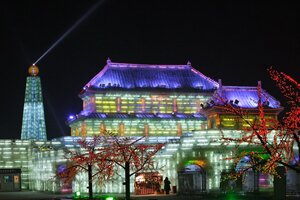

 Â
 
